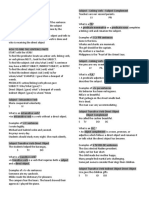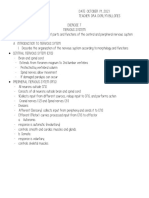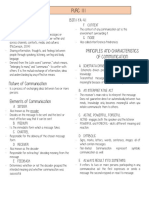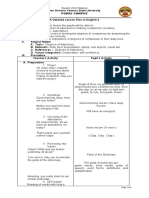Engl Transes Prelim
Engl Transes Prelim
Uploaded by
Gelo AlonzoCopyright:
Available Formats
Engl Transes Prelim
Engl Transes Prelim
Uploaded by
Gelo AlonzoOriginal Title
Copyright
Available Formats
Share this document
Did you find this document useful?
Is this content inappropriate?
Copyright:
Available Formats
Engl Transes Prelim
Engl Transes Prelim
Uploaded by
Gelo AlonzoCopyright:
Available Formats
ENGL 111
BSN1-YA-41
SENTENCE PATTERN
ELEMENTS OF A SENTENCE
• SUBJECT- doer of he action/ topic of the
sentence.
D. SUBJECT- LINKING VERB- SUBJECT
• PREDICATE- States something about the
COMPLEMENT
subject.
- A predicate adjective follows a linking verb and
• DIRECCT OBJECT- receives the action done
describes the subject.
by the subject.
• INDIRECT OBJECT- precedes the direct
object and tells to whom or for whom the
action of the verb is done and who is
receiving the direct object.
E. SUBJECT- TRANSUTIVE VERB- DIRET
BASIC SENTECNCE PATTERN OBJECT- OBJECT COMPLEMENT
A. SUBJECT-INTRANSITIVE VERB (S-IV) - Object Compliment- is a noun or pronoun or
- Intransitive Verb- is a verb without a direct adjective which follows a direct object and
object renames it or tells what the direct object has
become.
B. SUBJECT- TRANSITIVE VERB - DIRECT
OBJECT
- Transitive Verb- verb that requires both a F. SUBJECT- TRANSITIVE VERB- INDIRECT
subject and a direct object. OBJECT- DIRECT OBJECT
C. SUBJECT- LINKING VERB- SUBJECT
COMPLEMENT
- A predicate nominative or a predicate noun
completes a linking verb and renames the
subject.
ENGL 111
BSN1-YA-41
LISTENING lecture or listen to the election for finding a
- It is the process of receiving or constructing friend’s house.
meaning from and responding to A spoken or - Focuses on accurately understanding the
nonverbal messages (INTERNATIONAL READING meaning of the speaker’s words while
ASSOCIATION) simultaneously interpreting nonverbal cues such
as facial expressions gestures postures and
vocal quality.
TYPES OF LISTENING - During a question-and-answer sessions
speakers use comprehensive listening skills to
I. APPRECIATIVE LISTENING accurately interpret the audience question
- Listening for pleasure and enjoyment as well
when we listen to music to a comedy routine or STEPS IN ACTIVE LISTENING
doing entertaining speech. 1. Listening carefully by using all available
- Describes how well speakers choose and use senses
words use you more as questions tell stories 2. Paraphrasing what is her both mentally
and argue persuasively and verbally.
3. Checking your understanding danger
II. EMPHATIC LISTENING accuracy
- If I take listening to provide emotional support 4. Providing feedback
for the speaker as when a psychiatrist listens
to a patient or when we lend a sympathetic ear IV. CRITICAL/ANALYTICAL LISTENING
to a friend. - Listening to evaluate a message for purposes
- It focuses on understanding and identifying with of accepting or rejecting it as we listen to the
a person situation feeling or motives sales speech or of a used car dealer or the
- There is an attempt to understand what the campaign speech of a political candidate
other person is feeling - Focuses on evaluating whether a message is
- Descender desktop necessarily agree or feel logical and reasonable
the same way with the speaker instead - Asks you to make judgment based on your
understand the type and intensity of feeling the evaluation of the speaker arguments
speaker is experiencing without judgment. - Challenges the speaker’s message by evaluating
its accuracy and meaningfulness and utility
III. COMPREHENSIVE/ ACTIVE LISTENING - Uses critical thinking skills
- Listening to understand the message of a -
speaker as when we attend a classroom
ENGL 111
BSN1-YA-41
- Here is the package of letters.
➢ A singular verb must be used with the
singular indefinite pronouns each, neither,
either, anyone, everyone, no one,
someone, anybody, everybody, nobody,
somebody, anything, everything, nothing,
and something.
EXAMPLE:
SUBJECT-VERB AGREEMENT - Neither of the houses is worth much.
- Everyone is bringing his own car.
(Rules for Subject-Verb ➢ Some subjects, although they appear
Agreement) plural, are singular in meaning and take a
➢ A verb must agree with its subject in singular verb.
number. EXAMPLE:
EXAMPLE: - The news seems more and more depressing
- A book is on the table every day.
- My books are on the table - Measles is the only childhood disease I haven’t
➢ The number of a verb does not change had.
when one or more phrases come ➢ A singular verb is generally used after
between a verb and its subject or when words denoting an amount (time, money,
there is an intervening phrase. measurement, weight, volume)
EXAMPLE: EXAMPLE:
- The box of grapes from Saratoga Farms was - Three weeks is a long vacation
delivered today. - Two weeks was all the vacation he got.
- The clown with the sad eyes looks pathetic. ➢ A singular verb is generally used after a
- Anna, together with her friends, is going to collective noun. If the individuals of a group
the party.
act separately however, a plural verb
- The coins, along with this watch, were a gift.
must be used.
➢ The words here there and where are not
subjects they introduce a sentence in
EXAMPLE:
inverted order. The verb must agree with - The jury was out an hour only
the subject of a sentence - The team have received their letter
EXAMPLE:
ENGL 111
BSN1-YA-41
➢ When the conjunction “and” connects the
parts of compound subjects, the verb is LISTENING AND NOTE-TAKING TIPS
generally plural. However, if the subject is (GENERAL TIPS)
- Have a clear purpose
preceded by each, any or every, the verb
- Recognize main ideas
will be singular. - Identify the how information is organized
EXAMPLE: - Select inly relevant ideas
- My mother and father are old - Have a system of recording information that
- Each mother and father was recognized at works for you.
the meeting.
➢ When the conjunction or, nor, either.. or, or STRATEGIES TO INCREAS COMPREHENSIVE AND
neither.. nor connect the parts of a compound IMPROVE NOTE TAKING
subject, the verb will agree with the subject A. USE SYMBOLS AND ABBREVIATION
closer to it. - When taking notes, you can reduce the
EXAMPLE: amount g of language by shortening words and
- Either rain or snow is falling all over the state. sentence. Some ways of abbreviating re:
- Neither titles nor honors are everlasting a. Leaving out most artilcles and
- Neither the general nor his men are at the conjunction (the, a, and, but)
fort b. Shorten words by leaving out vowels or
- Either the apples or the large orange is for other letters (word truncation”
jack. c. Using abbreviation and symbols for
commonly used words and phrases
NOTE-TAKING B. USE CONCEPT MAPS AND DIAGRAMS
- Note taking involves active listening, as well as
connecting and relating information to ideas you NOTE TAKING SYSTEMS
already know. It also involves seeking answers A. THE CORNELL METHOD
to questions that arise from the material. B. THE OUTLINING METHOD
TAKING NOTES CAN HELP YOU TO: C. THE MAPPING METHOD
- Improve your understanding by making you D. THE CHARTING METHOD
convert difficult ideas into your own words. E. THE SENTENCE METHOD
- Prepare for writing fuller, better-connected
arguments in your essays
- Be more focused and time-efficient in your
exam revision period
- Asses your own progress as you study.
You might also like
- ENG 154 Study Notes For P2: Other Types of ListeningDocument3 pagesENG 154 Study Notes For P2: Other Types of Listeningreema ibra0% (1)
- (Cambridge Textbooks in Linguistics) April McMahon, Robert McMahon - Evolutionary Linguistics (2012, Cambridge University Press) PDFDocument331 pages(Cambridge Textbooks in Linguistics) April McMahon, Robert McMahon - Evolutionary Linguistics (2012, Cambridge University Press) PDFLaura Dumitrescu100% (1)
- Toefl Itp Score Interpretation: C1 B2 B1 A2Document3 pagesToefl Itp Score Interpretation: C1 B2 B1 A2Hector SandovalNo ratings yet
- Lesson Plan Mixed ConditionalsDocument3 pagesLesson Plan Mixed ConditionalsEvelyn GualdronNo ratings yet
- College English ReviewerDocument8 pagesCollege English ReviewerG4 AMOYO ANGELICA NICOLENo ratings yet
- College English 1Document13 pagesCollege English 1Jasmine Fritz CabreraNo ratings yet
- Engl Reviewer PrelimDocument11 pagesEngl Reviewer Prelimmaryannefernandez16No ratings yet
- Prelim Reviewer Engl 111Document7 pagesPrelim Reviewer Engl 111STEM 12- Cruz, SarahNo ratings yet
- College English Prelim ReviewerDocument4 pagesCollege English Prelim Reviewerbianca100% (1)
- Eng.107 MidtermDocument5 pagesEng.107 MidtermJeezreel AgadNo ratings yet
- Basic Sentence PatternsDocument2 pagesBasic Sentence PatternsSABORDO, MA. KRISTINA COLEEN100% (1)
- Purposive CommunicationDocument4 pagesPurposive CommunicationASTRA FAYE QUEENA DELENANo ratings yet
- Engl ReviewerDocument5 pagesEngl ReviewerPaula VargasNo ratings yet
- ENG111 ReviewerDocument5 pagesENG111 ReviewerFyo EstradaNo ratings yet
- Tangina Finals NaDocument3 pagesTangina Finals Na11 MIKALUGUD- Micaela DimacaliNo ratings yet
- College EnglishDocument4 pagesCollege Englishgolpomaria23No ratings yet
- ReviewerDocument3 pagesReviewerAxel De castroNo ratings yet
- English R - MidtermsDocument12 pagesEnglish R - MidtermsPrncess Ann TagupaNo ratings yet
- English Detailed LPDocument5 pagesEnglish Detailed LPshashamaepadillaNo ratings yet
- College English ReviewerDocument5 pagesCollege English ReviewervinxrieNo ratings yet
- Engl 111 TransesDocument3 pagesEngl 111 TransesChristina FloresNo ratings yet
- About The Module: Ready?Document9 pagesAbout The Module: Ready?Cheyenne LabiranNo ratings yet
- Purcom Midterm TransesDocument12 pagesPurcom Midterm TransesClementine RiveraNo ratings yet
- EL105 PrelimReviewerDocument3 pagesEL105 PrelimReviewerAeon Nico DimafelixNo ratings yet
- DLL2223 Eng7.1.4Document5 pagesDLL2223 Eng7.1.4April Joy ValdezNo ratings yet
- Case Lesson ReviewerDocument5 pagesCase Lesson ReviewerEmma AbapoNo ratings yet
- ENG111 Midterms ReviewerDocument9 pagesENG111 Midterms ReviewervinxrieNo ratings yet
- English 10Document4 pagesEnglish 10Kevinrich AlonzoNo ratings yet
- AssessmentDocument39 pagesAssessmentHamdhani Mulia Rahman El-shafaNo ratings yet
- DLL - English 1 - Q4 - W5Document5 pagesDLL - English 1 - Q4 - W5ricahjoy.rubricoNo ratings yet
- Final Assignment Modul 1Document3 pagesFinal Assignment Modul 1afriyantiNo ratings yet
- PREtest and Post Test ScaleDocument2 pagesPREtest and Post Test ScaleVira LledoNo ratings yet
- Epr - MidtermDocument4 pagesEpr - MidtermJasmine GonzalesNo ratings yet
- DLL - English 1 - Q4 - W5Document6 pagesDLL - English 1 - Q4 - W5hazelkia adrosallivNo ratings yet
- DLL July 18-22Document14 pagesDLL July 18-22JhuvzCLunaNo ratings yet
- Oral Communication GR11 ReviewerDocument2 pagesOral Communication GR11 Reviewerseulgi100% (2)
- Engl111 (Week 7)Document27 pagesEngl111 (Week 7)Ann Kristel EstebanNo ratings yet
- Semantics ReviewDocument6 pagesSemantics ReviewBích Trâm LêNo ratings yet
- Detailed Lesson Plan (Types of Sentence)Document5 pagesDetailed Lesson Plan (Types of Sentence)majeanabalosNo ratings yet
- Material PresentDocument82 pagesMaterial Present2157011061No ratings yet
- Reading Block Lesson Plan 2Document7 pagesReading Block Lesson Plan 2api-605341348No ratings yet
- Features of An Effective CommunicationDocument12 pagesFeatures of An Effective CommunicationZhaira PachecoNo ratings yet
- Argumentative Speech RubricDocument3 pagesArgumentative Speech RubricErnitaNo ratings yet
- Research PaperDocument3 pagesResearch PapervincentallitrapaneNo ratings yet
- English 1 - Q4 - W5 DLLDocument6 pagesEnglish 1 - Q4 - W5 DLLJanes Soria Abarientos ArquinezNo ratings yet
- Engl Prelim Exam ReviewerDocument3 pagesEngl Prelim Exam ReviewerFaithNo ratings yet
- Active and Passive Voice.pptxDocument36 pagesActive and Passive Voice.pptxMitch ButongNo ratings yet
- DLP g8 4th Context CluesDocument6 pagesDLP g8 4th Context Cluesmavlazaro.1995No ratings yet
- G10 English Q2 ReviewerDocument5 pagesG10 English Q2 ReviewerSteffani R. PeñasNo ratings yet
- Lesson Plan in English 9Document3 pagesLesson Plan in English 9edjean franciscoNo ratings yet
- Engl111 Prelims ReviewerpdfDocument11 pagesEngl111 Prelims ReviewerpdfAnah NicoleNo ratings yet
- Municative PPT - 1677730991000Document19 pagesMunicative PPT - 1677730991000dejenehundaol91No ratings yet
- Oral Communication For Finals NotesDocument11 pagesOral Communication For Finals NotesPullos, Gillian C.No ratings yet
- EL - 104 TEACHING READING PDFDocument29 pagesEL - 104 TEACHING READING PDFLevie AlposNo ratings yet
- FrankensteinDocument11 pagesFrankensteindelacruztephanieNo ratings yet
- Active PassiveDocument5 pagesActive PassiveStephany PacuñoNo ratings yet
- English 10 2ND Quarter ReviewerDocument5 pagesEnglish 10 2ND Quarter Reviewerhorfilla.angelo54No ratings yet
- Learning Outcomes: Asynchronous Task #1Document3 pagesLearning Outcomes: Asynchronous Task #1Wenzy Abella QuilantangNo ratings yet
- Engl111 (Week 3 - Listening)Document18 pagesEngl111 (Week 3 - Listening)Aaron Mhar GolosindaNo ratings yet
- ENGDocument99 pagesENGMarianne GonzalesNo ratings yet
- Eng ReviewerDocument3 pagesEng ReviewerBroniNo ratings yet
- Week 15 - ONCO COURSE TASK - Breast Cancer DetectionDocument3 pagesWeek 15 - ONCO COURSE TASK - Breast Cancer DetectionGelo AlonzoNo ratings yet
- Exercise 6Document6 pagesExercise 6Gelo AlonzoNo ratings yet
- Exercise 7Document7 pagesExercise 7Gelo AlonzoNo ratings yet
- Reproductive SystemDocument5 pagesReproductive SystemGelo AlonzoNo ratings yet
- Week 5 ExerciseDocument7 pagesWeek 5 ExerciseGelo AlonzoNo ratings yet
- LABORATORY EXERCISE The Gastrointestinal System With Accessory GlandDocument5 pagesLABORATORY EXERCISE The Gastrointestinal System With Accessory GlandGelo AlonzoNo ratings yet
- WEEK 16 LABORATORY EXERCISE Special SensesDocument7 pagesWEEK 16 LABORATORY EXERCISE Special SensesGelo AlonzoNo ratings yet
- WEEK 9 LABORATORY EXERCISE The Cardiovascular System, The Heart and The Blood VesselsDocument4 pagesWEEK 9 LABORATORY EXERCISE The Cardiovascular System, The Heart and The Blood VesselsGelo AlonzoNo ratings yet
- WEEK 15 LAB EXERCISE - Endocrine SystemDocument4 pagesWEEK 15 LAB EXERCISE - Endocrine SystemGelo AlonzoNo ratings yet
- WEEK 14 LABORATORY EXERCISE The Urinary SystemDocument2 pagesWEEK 14 LABORATORY EXERCISE The Urinary SystemGelo AlonzoNo ratings yet
- Purc Transes PrelimDocument4 pagesPurc Transes PrelimGelo AlonzoNo ratings yet
- BSN1-YA-41 Princinple of Art 1. Balance 3. EmphasisDocument2 pagesBSN1-YA-41 Princinple of Art 1. Balance 3. EmphasisGelo AlonzoNo ratings yet
- Supervisor Comments and Analysis 1Document5 pagesSupervisor Comments and Analysis 1Rania HosnyNo ratings yet
- Technical and Business Writing: The Link For Good Workplace/professional Communication By: Aaminah HassanDocument50 pagesTechnical and Business Writing: The Link For Good Workplace/professional Communication By: Aaminah HassanasdfNo ratings yet
- Communication Skills For Children With Severe Learning DifficultiesDocument10 pagesCommunication Skills For Children With Severe Learning DifficultiesMay Grace E. BalbinNo ratings yet
- BBNP4103 Penilaian PrestasiDocument6 pagesBBNP4103 Penilaian PrestasiENGKU NONI ENGKU ALAMNo ratings yet
- Tmr's Leader Term PaperDocument9 pagesTmr's Leader Term Paperagneschan2003No ratings yet
- Language and Youth Culture PDFDocument29 pagesLanguage and Youth Culture PDFAshu PrakashNo ratings yet
- Chapter 1. Communication (Mass Media)Document18 pagesChapter 1. Communication (Mass Media)dashingshlok460No ratings yet
- English LanguageDocument2 pagesEnglish LanguageDorina Danila100% (1)
- Primary Source Then & Now Project - Updated 012024Document4 pagesPrimary Source Then & Now Project - Updated 012024souljamann1No ratings yet
- LESSON PLAN EnglishDocument6 pagesLESSON PLAN EnglishMerry Jean BaraquielNo ratings yet
- Perkara Isi KandunganDocument2 pagesPerkara Isi KandunganAnonymous I1m68mssNo ratings yet
- Discourse Analysis: Three Ways of Looking at DiscourseDocument6 pagesDiscourse Analysis: Three Ways of Looking at DiscourseFlorencia Oviedo AguirreNo ratings yet
- Kannada Versus Sanskrit: Hegemony, Power and Subjugation: Dr. Meti MallikarjunDocument18 pagesKannada Versus Sanskrit: Hegemony, Power and Subjugation: Dr. Meti MallikarjunBruce WayneNo ratings yet
- The Impact of Oplan Tutok Basa Program Among Grade One Pupils in A Sampled Public Elementary SchoolDocument3 pagesThe Impact of Oplan Tutok Basa Program Among Grade One Pupils in A Sampled Public Elementary SchoolDan Joven BriñasNo ratings yet
- Didactic Unit Foods&DrinksDocument14 pagesDidactic Unit Foods&Drinksese_nietoNo ratings yet
- Name: Radu Izabela Departament: Week: 1Document9 pagesName: Radu Izabela Departament: Week: 1Macarie IoanaNo ratings yet
- Intermediate Word of The Day QuizDocument3 pagesIntermediate Word of The Day QuizFrancisco Luis Polo HernándezNo ratings yet
- Communication Aids and Strategies Using Tools of TechnologyDocument17 pagesCommunication Aids and Strategies Using Tools of TechnologyRose Ann CalderonNo ratings yet
- Rivas, Angielyn & Rivas, Donna - Final PaperDocument8 pagesRivas, Angielyn & Rivas, Donna - Final PaperMichelle AlonteNo ratings yet
- Natural Language Processing: A Beginner's Guide To Fundamentals ofDocument14 pagesNatural Language Processing: A Beginner's Guide To Fundamentals ofNilesh PatilNo ratings yet
- Deep Structure - Definition and Examples of Deep Structures in Transformational GrammarDocument2 pagesDeep Structure - Definition and Examples of Deep Structures in Transformational GrammarIbnu Shollah Nugraha100% (2)
- Nonverbal Dating QuesDocument19 pagesNonverbal Dating QuesJames Jenkins50% (2)
- English 8 q2 DLLDocument3 pagesEnglish 8 q2 DLLBless MendozaNo ratings yet
- Drafting LangDocument9 pagesDrafting LangKushang SinghNo ratings yet
- DLL 1st Quarter wk4 Grade8-September-18-22-2023Document5 pagesDLL 1st Quarter wk4 Grade8-September-18-22-2023bernaflor pacantara100% (1)
- ExamDocument3 pagesExamJoie Lynn LiberatoNo ratings yet




































































































